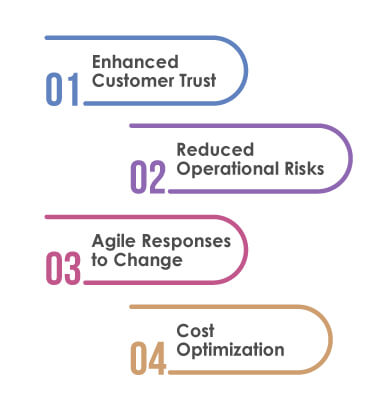
- Digital Assurance – Bringing a Shift in Insurance
- The Role of Customer Experience in the Digital Age
- Benefits of Digital Assurance in Insurance
- Challenges and Considerations in Implementing Digital Assurance
- Digital Assurance in Action
- Conclusion
- How Can TestingXperts help you with Digital Assurance in Insurance
The advent of digital transformation in the insurance sector has brought about unprecedented changes. With the surge in customer expectations and the rise of innovative technologies, insurance companies are tasked with not only embracing digital solutions but ensuring a seamless and secure experience for their customers. This blog explores the significance of digital assurance in the insurance sector and how it serves as a nucleus for delivering an enhanced customer experience.
Digital Assurance – Bringing a Shift in Insurance
The shift towards digitalization in the insurance sector has been monumental. From online policy purchases to mobile claim processing, insurers are leveraging digital channels to streamline operations, enhance efficiency, and, most importantly, improve customer interactions. However, this digital shift comes with its set of challenges, and ensuring a robust digital infrastructure is imperative to meet customer expectations.
The Role of Customer Experience in the Digital Age
Today, customers expect seamless interactions, personalized services, and quick responses. As a result, insurers are shifting their focus from traditional product-centric approaches to customer-centric strategies. This shift is not just about offering better products; it’s about delivering a holistic experience that encompasses every touchpoint in the customer journey.
In the insurance industry, where trust and reliability are paramount, providing an exceptional customer experience is a strategic imperative. Insurers recognize that satisfied and loyal customers are more likely to renew policies, recommend services to others, and become long-term partners. Achieving this level of customer satisfaction requires a robust and reliable digital infrastructure, and this is where digital assurance steps in.
Benefits of Digital Assurance in Insurance
Enhanced Customer Trust:
Trust is the bedrock of the insurance industry. Digital assurance instills confidence in customers by ensuring the reliability and security of digital systems. When customers trust that their data is secure and that digital platforms work seamlessly, they are more likely to engage with digital channels, leading to a positive overall experience.
Reduced Operational Risks:
Digital assurance minimizes the risk of technical glitches, system failures, and security breaches. By proactively addressing these risks, insurers can avoid costly disruptions to their operations and prevent potential damage to their reputation. This not only safeguards customer information but also ensures the uninterrupted delivery of services.
Agile Responses to Change:
The insurance landscape is continually evolving, with changes in regulations, market dynamics, and customer expectations. Digital assurance enables insurers to adapt swiftly to these changes by ensuring that their digital systems are flexible and scalable. This agility is crucial for staying ahead in a competitive market and responding promptly to emerging trends.
Cost Optimization:
Investing in digital assurance may seem like an additional cost, but it is a strategic investment that can lead to long-term cost savings. By identifying and rectifying issues early in the development cycle, insurers can avoid expensive fixes and reduce the overall cost of maintaining digital systems.
Challenges and Considerations in Implementing Digital Assurance
While the benefits of digital assurance are evident, implementing it in the insurance sector comes with its own set of challenges:
Legacy Systems Integration:
Many insurers operate on legacy systems that may not be easily compatible with modern digital assurance practices. Integrating digital assurance into these systems requires careful planning and may involve significant investments in technology upgrades.
Data Privacy and Compliance:
The insurance industry is subject to stringent data privacy regulations. Ensuring compliance with these regulations while implementing digital assurance measures is crucial. Insurers must navigate a complex landscape of privacy laws and regulations to protect customer data adequately.
Talent and Skill Gaps:
The successful implementation of digital assurance requires skilled professionals with expertise in areas such as cybersecurity, data analytics, and quality assurance. The industry is facing a shortage of such talent, making it challenging for insurers to build and maintain robust digital assurance capabilities.
Digital Assurance in Action

Improved Claims Processing with Predictive Analytics:
One major pain point for insurance customers is the claims process. Long waiting times and complex procedures can lead to dissatisfaction. To address this, an insurance company implemented digital assurance practices, leveraging predictive analytics to assess and process claims more efficiently. This not only reduced the time taken for claims processing but also improved accuracy, leading to higher customer satisfaction.
Secure Customer Portals for Policy Management:
An insurance provider revamped its customer portal to allow policyholders to manage their policies online. Digital assurance played a crucial role in ensuring the security of the portal, protecting sensitive customer information. This move not only provided customers with a convenient way to access and update their policies but also strengthened the insurer’s reputation for safeguarding customer data.
Conclusion
The integration of digital assurance in the insurance sector stands as a transformative force, propelling the industry towards a future where customer experience takes center stage. By ensuring the reliability, security, and performance of digital systems, insurers can build trust, reduce operational risks, and respond agilely to changes in the dynamic landscape. The tangible benefits of enhanced customer trust, streamlined processes, and reduced operational costs underscore the strategic importance of digital assurance in delivering a superior customer experience. As technology continues to evolve, embracing trends like AI, automation, and blockchain, the future of digital assurance in insurance promises not only to meet but to exceed customer expectations. In this digital age, where customer satisfaction is paramount, investing in digital assurance is not just a technological necessity; it is a strategic imperative that will shape the success and sustainability of insurance companies in the years to come.
How Can TestingXperts help you with Digital Assurance in Insurance
TestingXperts can help you in enhancing the user experience through Digital Assurance in the insurance sector. By employing robust testing methodologies, TestingXperts ensures the seamless functioning of digital platforms, including web and mobile applications, chatbots, and other digital interfaces integral to insurance operations.
Through comprehensive end-to-end testing, we can identify and rectify any glitches or bottlenecks in the insurance process, from online quoting and policy issuance to claims processing. This meticulous approach guarantees a user-friendly and efficient experience for policyholders. Moreover, by offering multi-channel testing services, TestingXperts ensures consistency across diverse platforms, ensuring that users receive a cohesive and reliable experience regardless of the channel they choose. In doing so, TestingXperts contributes significantly to elevating the overall user experience in the digital landscape of insurance.
Discover more
Get in Touch
Stay Updated
Subscribe for more info









